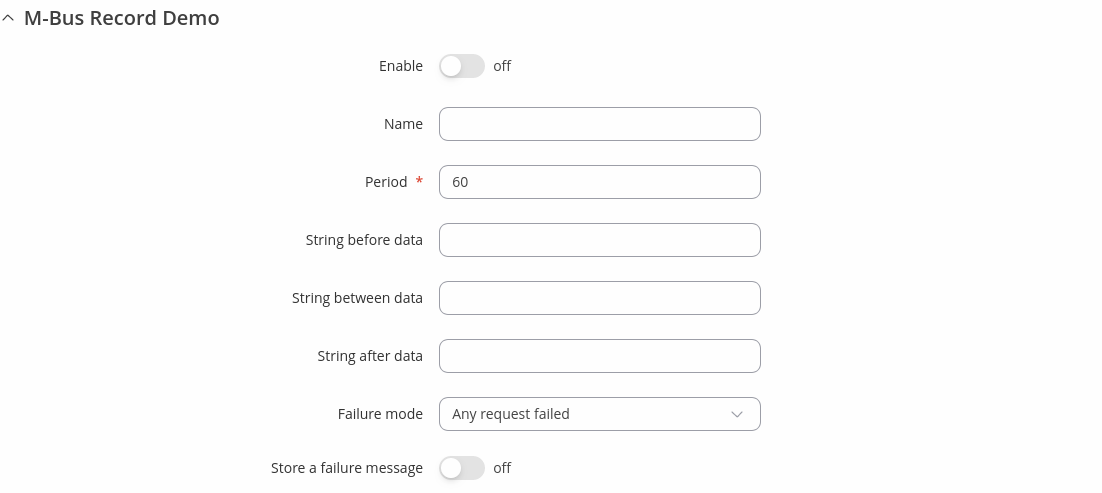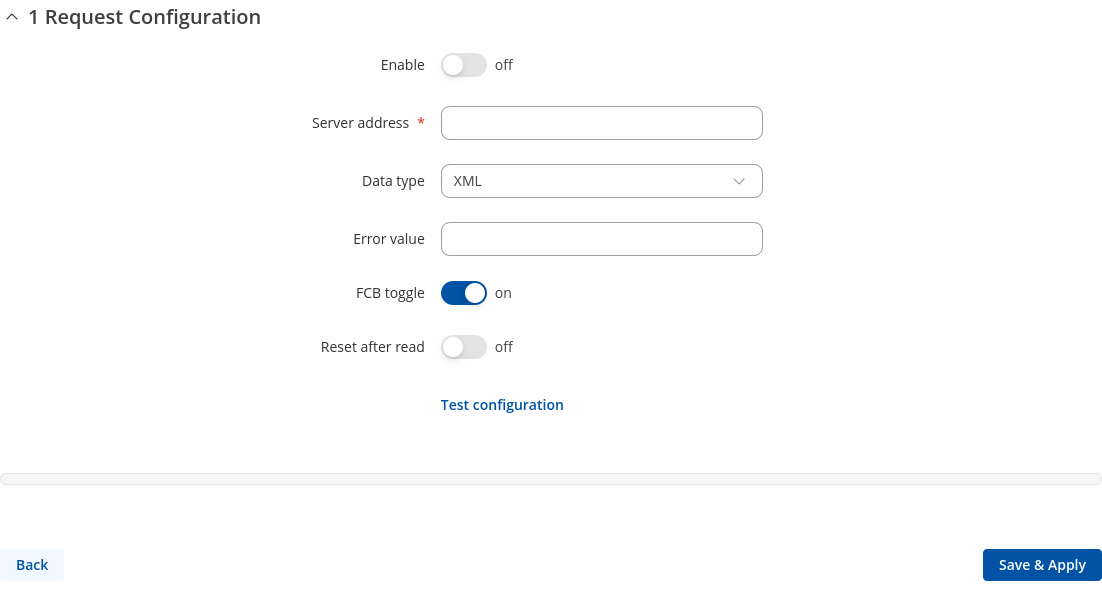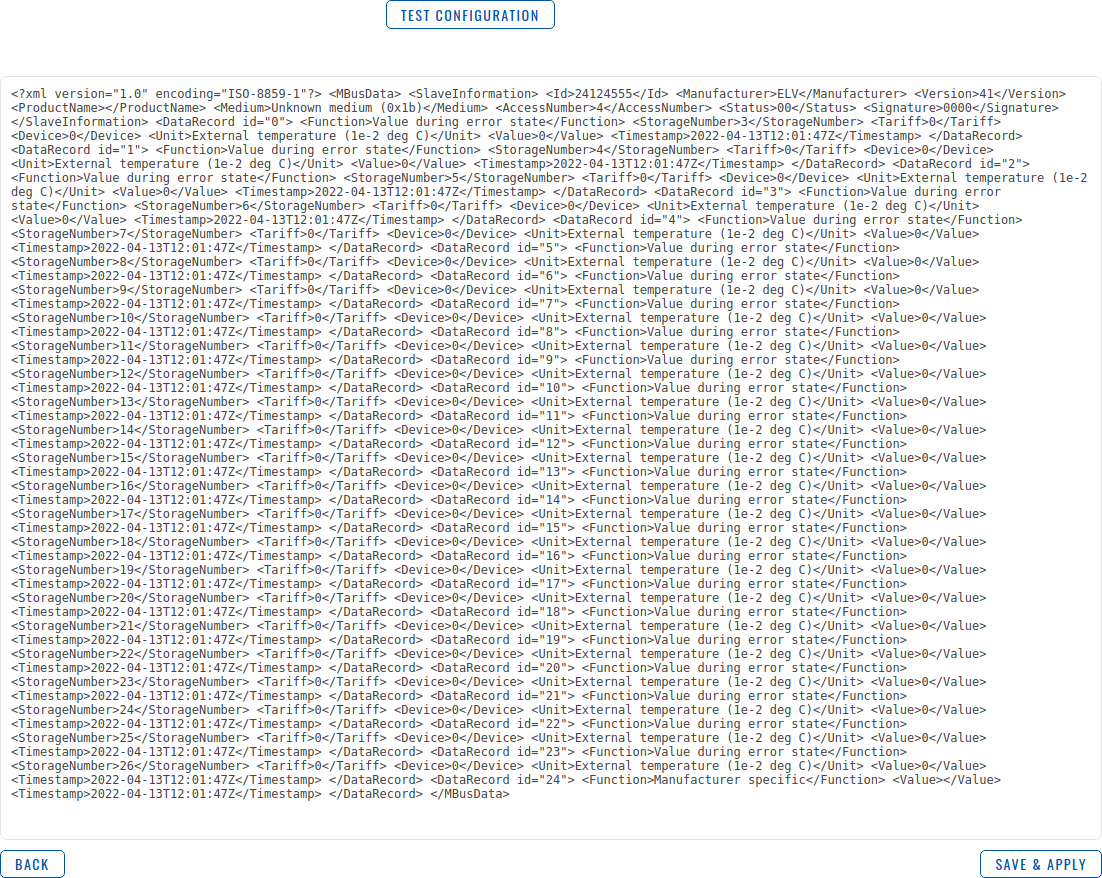Template:Networking rutos manual mbus: Difference between revisions
Gytispieze (talk | contribs) m (Text replacement - "\{\{Template: Networking_rutos_manual_fw_disclosure (.*) (.*) (.*) (.*) \}\}" to "{{Template: Networking_device_manual_fw_disclosure | series = {{{series}}} | name = {{{name}}} | fw_version ={{Template: Networking_device_manual_latest_fw | series = {{{series}}} | name = {{{name}}} }} }}") |
No edit summary |
||
| Line 53: | Line 53: | ||
The <b>M-Bus Record</b> section is used to configure the general record instance. The figure below is an example of the M-Bus Record and the table below provides information on the fields contained in that section: | The <b>M-Bus Record</b> section is used to configure the general record instance. The figure below is an example of the M-Bus Record and the table below provides information on the fields contained in that section: | ||
[[File: | [[File:Networking_rutos_manual_mbus_record_mbus_record_demo_v4.png|border|class=tlt-border]] | ||
<table class="nd-mantable"> | <table class="nd-mantable"> | ||
| Line 111: | Line 111: | ||
====Request Configuration Edit==== | ====Request Configuration Edit==== | ||
---- | ---- | ||
[[File:Networking rutos manual mbus record request configuration edit | [[File:Networking rutos manual mbus record request configuration edit v4.png|border|class=tlt-border]] | ||
<table class="nd-mantable"> | <table class="nd-mantable"> | ||
| Line 143: | Line 143: | ||
<td>off | on; default: <b>on</b></td> | <td>off | on; default: <b>on</b></td> | ||
<td>FCB (Frame Count-Bit): One-bit counter for reliable server-client communication; some devices have special uses for it.</td> | <td>FCB (Frame Count-Bit): One-bit counter for reliable server-client communication; some devices have special uses for it.</td> | ||
</tr> | |||
<tr> | |||
<td>Reset after read</td> | |||
<td>off | on; default: <b>off</b></td> | |||
<td>Resets the device after every read.</td> | |||
</tr> | </tr> | ||
<tr> | <tr> | ||
Revision as of 12:34, 10 May 2024
The information in this page is updated in accordance with firmware version .
Summary
The M-Bus (Meter Bus) is a cost-effective fieldbus communication protocol for transmitting energy consumption data. A central client – in this case {{{name}}} – communicates via a two-wire bus (up to max. 250 servers per segment) with bus devices (e.g., heat meter, water meter, electric meter, gas meter).
This manual page provides an overview of the M-Bus functionality in {{{name}}} devices.
M-Bus Settings
The M-Bus Settings section is used to configure the general service functionality. The figure below is an example of the M-Bus Settings and the table below provides information on the fields contained in that section:
| Field | Value | Description |
|---|---|---|
| Enable | off | on; default: off | Enables the service. |
| Baud rate | 300 | 600 | 1200 | 2400 | 4800 | 9600 ; default: 2400 | Specifies the M-Bus server network baud rate. |
| Database location | RAM memory | Flash memory; default: RAM memory | Specifies where the database will be stored.. |
Records
By default there are no Records instances created. To start configuring, add a new record using the Add New Instance section below.
M-Bus Record
The M-Bus Record section is used to configure the general record instance. The figure below is an example of the M-Bus Record and the table below provides information on the fields contained in that section:
| Field | Value | Description |
|---|---|---|
| Enable | off | on; default: off | Enables the service. |
| Name | string; default: none | Name used for distinguishing purposes. |
| Period | integer [1..86400]; default: 60 | Specifies the period how often record data will be collected. |
| String before data | string; default: none | String that will be appended before request data. |
| String between data | string; default: none | String that will be appended between request data. |
| String after data | string; default: none | String that will be appended after request data. |
| Failure mode | Never | Any requests failed | All requests failed; default: Never | Specifies when whole record is considered as failure. |
| Store a failure message | off | on; default: off | Select whether to store a failure message in the database or do nothing on failure. |
Request Configuration
In this section, you can configure requests from servers. By default there are no instances created. To add a new instance and start configuring press the Add button.
Request Configuration Edit
| Field | Value | Description |
|---|---|---|
| Enable | off | on; default: off | Enables request processing. |
| Server address | int | hexstring; default: none | Address of the server to be inquired. |
| Data type | XML | HEX | BIN | JSON; default: XML | Data type to process the received data. |
| Error value | string; default: none | Changes request data to this value if request fails. |
| FCB toggle | off | on; default: on | FCB (Frame Count-Bit): One-bit counter for reliable server-client communication; some devices have special uses for it. |
| Reset after read | off | on; default: off | Resets the device after every read. |
| Test configuration | button; default: - | Tests the current configuration. |
Test Configuration
Before saving, you can check if your configuration works accordingly by pressing the Test Configuration button. You should see the data in a field below:
[[Category:{{{name}}} Services section]]






